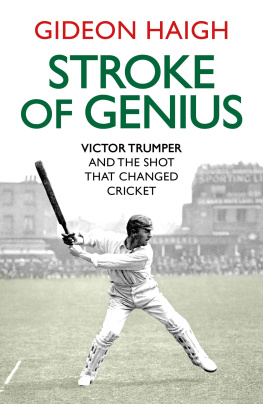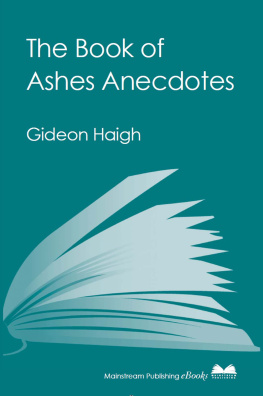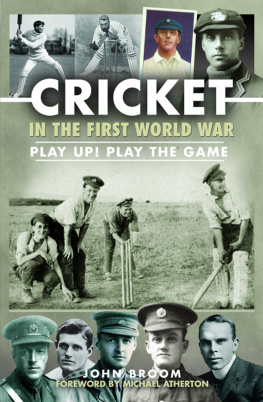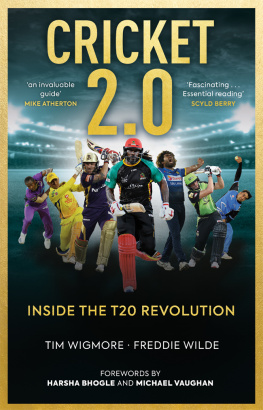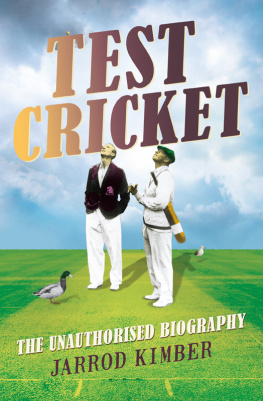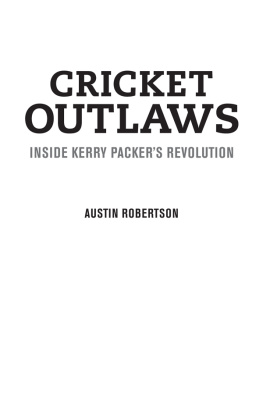Sphere of Influence

First published by Victory Books,
an imprint of Melbourne University Publishing, in 2010
First published in Great Britain in 2011 by Simon & Schuster UK Ltd
A CBS COMPANY
Copyright 2010, 2011 by Gideon Haigh
This book is copyright under the Berne Convention.
No reproduction without permission.
All rights reserved.
The right of Gideon Haigh to be identified as the author of this work has been asserted by him in accordance with sections 77 and 78 of the Copyright, Designs and Patents Act, 1988.
Simon & Schuster UK Ltd
1st Floor
222 Grays Inn Road
London
WC1X 8HB
www.simonandschuster.co.uk
Simon & Schuster Australia, Sydney
Simon & Schuster India, New Delhi
The publishers have made every effort to contact those holding rights in the material reproduced in this book. Where this has not been possible, the publishers will be glad to hear from those who recognise their material.
A CIP catalogue copy for this book
is available from the British Library.
ISBN: 978-0-85720-684-8
eBook ISBN: 978-0-85720-900-9
Design and typography Melbourne University Publishing Limited, 2010
Printed in the UK by CPI Cox & Wyman, Reading, Berkshire RG1 8EX
Contents
INTRODUCTION
A World of Worry
The British Sphere of Influencethe cricket ball.
Anonymous, Mr Punchs Book of Sport (1907)
In the Victorian era, cricket was an Anglo-Saxon political tool
to civilise the world. Today is an Eastern economic imperialism rooted in cricket about to commence?
Boria Majumdar, An Illustrated History of Indian Cricket (2007)
Does any game worry more than cricket? There are the on-field frictions: sledging, appealing, chucking, cheating. There are off-field fixations: administrative lapses, player peccadillos. The onetime game of Empire sinks readily into postcolonial brooding on nation, race, religion, sovereignty, security. Each of the three forms of international competition has become freighted with concerns. Is Test cricket too old-fashioned? Is one-day cricket too formulaic? Is Twenty20 cricket too successful, and might it eclipse either of the others, or both?
For all that, cricket is a micro-worrier. Its Laws are voluminous, its codes of conduct and definitions of fair play constantly expanding, its systems of adjudication neurotic in their sophistication. Yet to truly big issues, like its governance structure and global economy, there is a kind of studied indifference. The International Cricket Council? Beyond redemption. The Board of Control for Cricket in India? Beyond restriction. The players? Too greedy. The media? Too cynical. Can we just watch, please? Well be good, really we willjust dont let them take our lovely game away.
What constitutes crickets welfare, meanwhile, is seldom addressed in other than banal terms. Cricket must grow. Cricket must change with the times. Cricket must expand its audience. Because, you know, lots of people are running around saying that cricket must shrink, must turn back the clock and reduce its audience, arent there? As one modern expert puts it:
The game is definitely at the coalface of anticipated change. What I can bring to the table is a real currency and a slightly more contemporary style of looking at the way cricket and the business of cricket is managed and maintained. Strategically its really important to recognise that iconic series such as the Ashes can never be removed, and in fact need to be protected and maintained, throughout the cricketing landscape. At a time when the market is looking to find new ways to engage our sport I think its also really important to go on a journey and go on a debate and recognise that we have got something very special in the creation of franchise cricket and the globalisation of those brands.
The qualifications for this speaker are not, surprisingly, an MBA and a decade at McKinsey, but 8625 Test runs at 50.7. Matthew Hayden, for it is he, joined the Cricket Australia board a year ago, seamlessly swapping a bat for a Blackberry, already as fluent in jargon as he was through the covers. And when the cricketers already sound like marketing wise-guys, just imagine what the marketing wise-guys sound like
Ostensibly, authority for global cricket is vested in the ICC, with its ten full (Test-playing) members, and thirty-four associate and sixty affiliate members. In reality, such a large proportion of the games commercial activity and fans are located in India that nothing happens without the say-so of the mahouts aboard the thirty-one-member elephant that is the BCCI, whose annual revenues for 201011 were set to exceed US$400 million. And modern crickets lucrative instability stems from nowhere but the BCCIs creation of supranational Twenty20 attractions beyond the jurisdiction of the ICC, offering rewards by comparison with which those in the established international game pale.
Arguably, no single game is bigger in any single country: the dynamism of Indias economy, growing between 4 per cent and 10 per cent annually during the twenty-first century, and the size and shape of Indias population, 1.2 billion people, half of them under twenty-five, make it so. India is also, of course, a bafflingly diverse and contradictory country, containing four of the worlds eight richest men and 40 per cent of its chronically malnourished children, possessed of a world-class information technology industry while two-thirds of its people remain dependent on agriculture and half have no electricity, proud to espouse free-market turbocapitalism while ranking 133rd out of 183 countries in ease of doing business according to the World Banks 2010 Doing Business Report. But its people, for all their huge and minute differences of ethnicity, religion, caste, wealth and education, share an incandescent passion for cricketwhich makes cricket a key means of exploiting its new prosperity.
What follows are my own attempts at intervals over the last two years to make sense of crickets new order: the spread of Twenty20 and of private ownership, the eclipse of international crickets other formats and of the ICC, the rise of India, the tribulations of Pakistan, the prodigies of Lalit Modi, the false promise of Allen Stanford. My background in journalism is in business. At times, it feels like I have come full circle. Historically, cricket has been the most traditional of games; it has developed a taste for change bordering on compulsive. Prognostication is perilous under such circumstances; on the other hand, like going for a catch maybe slightly out of your reach, theres no harm trying.
Sphere of Influence begins with a detailed recapitulation of the key events in the emergence of India as crickets unipolar superpowerso often experienced today as a fact of life rather than what it is: the product of cultural, political and economic forces. It also contains reviews of the on-field fortunes of Australia and the Subcontinent in this era, plus a look at some of their recent past masters, and some rueful reflections on the recent spot-fixing saga. Fortunately for me, enough things have not changed that I can still find good editors to rely on, content to indulge my gropings towards an understanding of the shape of cricket now: Sambit Bal, Scyld Berry, Suresh Menon, Boria Majumdar, Sally Warhaft, Seamus Bradley, Tim Blair, Tom Switzer, and the late, lamented Vinay Verma. I thank them all. Sphere of Influence has been experienced by my wife, Charlotte, and daughter, Cecilia, meanwhile, as a sequence of all-too-frequent vanishing acts. I dedicate it to them with love and apology.




